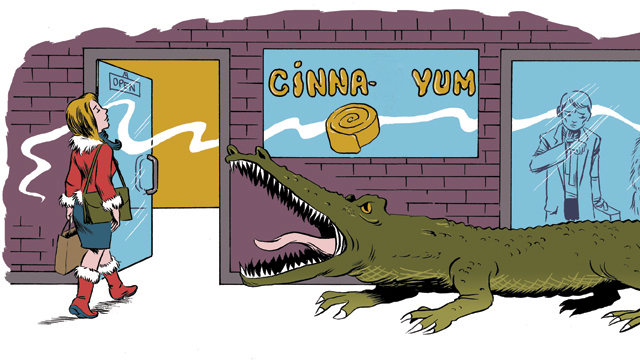Would you enjoy eating semi-decayed raw crocodile? I ask this because I’ve been thinking about semi-decayed raw crocodile all day — ever since I read an article in National Geographic about how all of our big, fat, useful human brains might have evolved because of our distant ancestors’ taste for scavenged crocodile-carcass sushi. Really!
Sometime about 3 million to 1.8 million years ago, hominins (various prehumans and their relatives) got to eating reptile carcasses, especially crocodiles, and the long-chain polyunsaturated fatty acids found in said dead crocs provided the nutrients early humans needed to start building bigger brains.
My first thought about this research was: Yuck! Semi-decayed raw crocodile. My second: I wonder how long until someone markets semi-decayed raw crocodile as the Original Human Brain Food. And would I have an appetite for it?
Appetite, of course, is as culturally determined as everything else. You can’t turn on the television today without seeing someone eating something that we find quite weird that other cultures find quite normal. In Korea, for instance, silkworm larvae are a popular street food for kids.
But it’s not just individual foods that we have an appetite for (or don’t). Appetite itself has become an engineered thing. I thought of this recently when a friend was explaining the “Cinnabon effect” to me — that is, when you’re walking past a Cinnabon stand at the mall and you’re sucked in by the wonderful scents and suddenly find yourself ingesting a billion calories, no matter whether or not you’re really hungry.
Although the sensory temptation and omnipresent availability of such modern-day foods have certainly complicated matters, our struggles to make peace with our eating instincts are nothing new. Today we have the Cinnabon effect, but a few hundred years ago we had . . . gluttony.
Basically, gluttony was a Judeo-Christian sin, likely created to help Judeo-Christians define themselves in contrast to Romans (who loved eating as much food as possible — including, but not limited to, whole, boiled ostriches).
Once the idea of gluttony got going, it really took off. St. Thomas Aquinas thought about gluttony so much that he defined a full six stages: Praepropere (eating too soon), Laute (eating too expensively), Nimis (eating too much), Ardenter (eating too eagerly), Forente (eating too wildly), and Studiose (eating too daintily).
I think I’ve hit all of those stages of gluttony, sometimes in a single weekend. Consider: It’s a Friday afternoon in New York City. I’m meeting another restaurant critic, one with a much larger expense account, to try a little sushi counter that everyone’s writing about. We check it out and after a few courses dash off — to dinner at a very avant-garde French restaurant with some very avant-garde people. After five courses (including cheese and dessert, naturally — how can you judge a restaurant if you don’t see how it cares for and presents its cheese?), we’re off — to meet some folks at a Greek restaurant, where whole fish must be tasted and judged.
When midnight rolls in, I have been eating for eight hours straight. Much has been learned. Invaluable networking has been networked. But still. On the way home, we stop to check out a new wine bar and order more cheese, because they have a cheese that’s never before been imported into the country. At 3 o’clock in the morning, I am too full to sleep. At this point, I have hit five of the six stages of gluttony, and now it’s time for Studiose, eating too daintily.
The next day I eat nothing. I imagine this is what it’s like to have felled and eaten an entire mastodon. Seventy-two hours after my three dinners, I still haven’t eaten, my hands are like ice, and I’m staring at my computer on a deadline with tears leaking out of my eyes. “What’s wrong?” asks my husband.
“Everything!” I wail. “There are earthquakes, human tragedies, disasters all over the news. Why did I take all those poetry electives in high school? I could have been a doctor or a parachuting firefighter, and then I could save earthquake victims or . . . ”
“Honey, when was the last time you ate anything?” he inquires. A snack is prescribed, administered and fixes everything.
So now this is a question I have trained myself to ask when things seem most awful: When was the last time I ate anything? I’m shocked and embarrassed at how often the answer is: yesterday. Embarrassed because it seems that, as a grown woman with children who look to me for guidance, I should have figured out this whole appetite thing by now.
It’s not rocket science. It’s not even building a Lego rocket. It’s much more basic than that. But restaurant critics provide a good example of appetite totally subsumed to life’s other demands — a dynamic most of us face on a daily basis, albeit in totally different ways.
For instance, because of the bizarre roller coaster of feast-and-keep-feasting my job requires, I tend to opt out of voluntary eating I can’t write about: I don’t eat the cookies people leave in the office kitchen; I never grab a free mint; I don’t eat the cheese cubes at the awards reception.
But it makes people very uncomfortable when you don’t eat the cheese cubes at the reception. First, a woman will offer to make a plate and hand it to me, as if the only reason one wouldn’t eat communally offered food was physical impairment. Next, somebody will make a crack about food poisoning or wonder aloud, half-jokingly: “What, this food not good enough for you?”
One way or another, most of us have encountered similar pressures — to override our natural instincts, to give in to externally triggered cravings, or to ignore our hunger signals altogether. (Honey, when was the last time you ate anything?)
Yet despite all this, we’re still a terrifically successful species — billions and billions of us now, on every continent — and we got here, in large part, by eating. We started eating some crocodile carcasses, we went on to eat all the mastodons, we boiled an ostrich or two whole, we repented of gluttony, we went out for Cinnabons.
I guess we’re still just struggling to sort it all out. So what’s the solution? Given the confusing food environment we live in today, probably the best advice is to listen to your own body. But that approach doesn’t work for me — not anymore, anyway. Whatever switch in the human body regulates appetite, I blew it out long ago.
And I suspect I’m not alone. We’ve all been faced with too many doughnuts and deadlines at work, too many dinners out, too many well-meaning loved ones who’ve made us a plate of extra cheese cubes for later.
As a result, when we ask our bodies what they’re hungry for — or if they’re hungry at all — they’re not always sure what to say.
That’s why I try to keep a running tally in my head, these days, of when and what I’ve eaten. I make adjustments when necessary. And all the while I try to keep in mind: Humans have always been driven by our appetites, from crocodile carcasses to mastodons to Cinnabons. Failure is part of being human, and forgiving yourself is necessary, too: Dear God, give us this day our daily bread, a little crocodile, mastodon, or cinnamon to go on it, the wisdom to know how much of it to eat, and the strength to forgive ourselves if we wind up eating — or not eating — something we later regret.
Dara Moskowitz Grumdahl is a celebrated food and wine critic. She is the winner of five James Beard Foundation awards — the Oscars of the food world. Her new book is Drink This: Wine Made Simple (Ballantine, 2009).


This Post Has 0 Comments